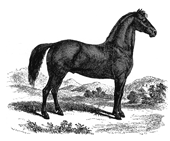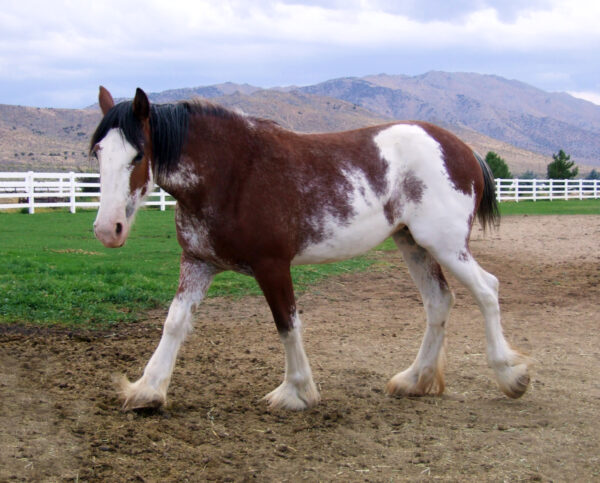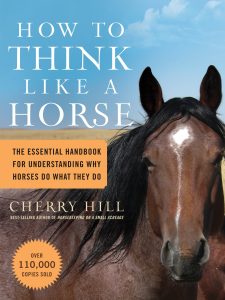
Breed Facts
Status:
Threatened
Use:
Draft
Adult Weight:
1600 – 2000 lbs
Temperament:
Docile
Experience Level:
Intermediate
Notes:
Large, heavy draft horse, calm and stylish, distinctive gait, feathered feet
CLYDESDALE
The Clydesdale is a draft horse breed from Lanarkshire, Scotland whose name is derived from the River Clyde. Their history goes back to the mid-1700s when native horses were mated with larger Flemish horses. Their offspring were then selected for use in agriculture and for all types of heavy hauling, including transport through the streets of Glasgow. Clydesdale horses were first exhibited under the breed name in 1826, and were further standardized through the system of hiring out purebred stallions. The Clydesdale Horse Society was formed in 1877, and its breed registry records go back to the 1830s.
The Clydesdale was first imported to North America in the 1840s. The breed’s attractiveness and size led to its use in promotional hitches, such as one sponsored by the Chicago Stockyard Company. In the 1930s, the Anheuser-Busch Company of St. Louis, Missouri, began to use a hitch of Clydesdales to celebrate the end of Prohibition and to represent the company’s products. The “Budweiser Clydesdales” were an immediate sensation when they delivered the first post-Prohibition beer to the White House, and the hitch has proven to be one of the most popular and successful advertising symbols of all time. Less well known is the fact that Anheuser Busch has maintained a Clydesdale breeding program since 1953, and that the company’s commitment to the breed during the 1950s and 1960s was critical to its survival in North America. (The Budweiser Clydesdales were once found at Busch Gardens amusement parks, but when parks were sold by InBev in 2009, the connection to the Budweiser Clydesdales ended. The new owners brought in Clydesdale horses, but they are no longer “Budweiser Clydesdales.”)
The Clydesdale combines strength and style. The breed’s action is distinctive, with each foot lifted cleanly off the ground so that the bottom of the foot is visible from behind. The forelegs are well planted under the shoulders, the legs are straight, and the feet are durable. Clydesdales should have breadth between the eyes, with a flat facial profile and a wide muzzle. The withers are high, the back short, and the quarters long and well-muscled. The most common color is bay, though black, brown, chestnut, and roan are also seen. The Clydesdale resembles the Shire, and the breeds are related.
As with many breeds of livestock, Clydesdales evolved to meet the changing demands of the times. In the early 1900s, the market favored a compact animal. More recently, breeders have selected taller horses to be used in fancy hitches and in the show ring. Today’s Clydesdales stand 16.2-18 hands (66–72″) at the withers and weigh 1,600-1,800 lbs. The largest individuals are taller, weighing as much as 2,200 pounds.
Despite their giant size, Clydesdales have a laid-back, “happy” disposition. They are intelligent and easy to train. They make good family horses, even for beginners. They are a hardy breed that generally does well in cold weather. However, due to their size, they are more expensive to keep than other horse breeds. They eat more, require at least a 24’ x 24’ stall for horses let out daily, and cost more to shoe.
The North American population of Clydesdale horses had increased steadily for several decades, but a sharp decline began around 2010, prompted by the economic downturn that affected the entire equine market. Globally, the breed is well known but not common, with an estimated global population of fewer than 5,000 horses.
Did you know:
No breed included on the Conservation Priority List has gone extinct since The Livestock Conservancy began work in 1977. Fourteen breeds have graduated off the CPL since 2014, including the Wyandotte chicken in 2016, Highland cattle in 2019, and Hereford pigs in 2024.

Breed Facts
Status:
Threatened
Use:
Draft
Adult Weight:
1600 – 2000 lbs
Temperament:
Docile
Experience Level:
Intermediate
Notes:
Large, heavy draft horse, calm and stylish, distinctive gait, feathered feet
You may be interested in…
Managing Breeds for a Secure Future
By Dr. Phil Sponenberg, Dr. Alison Martin, Jeannette Beranger
$34.95
Manual of Methods for Preservation of Valuable Equine Genetics
By Kindra Rader, Charles C. Love, Charlene R. Couch and Katrin Hinrichs
$19.95






